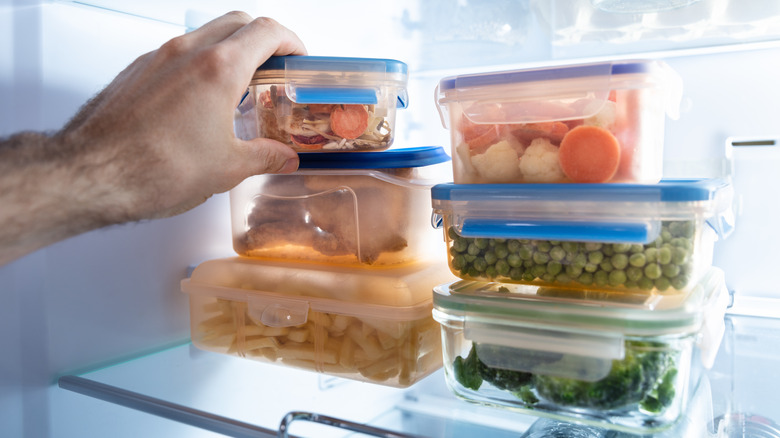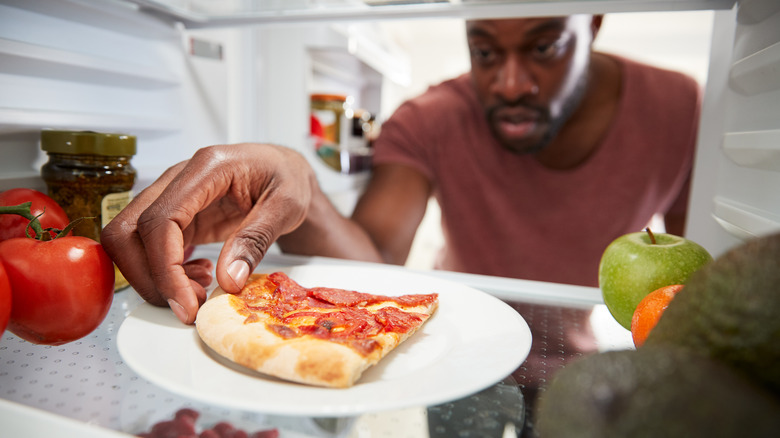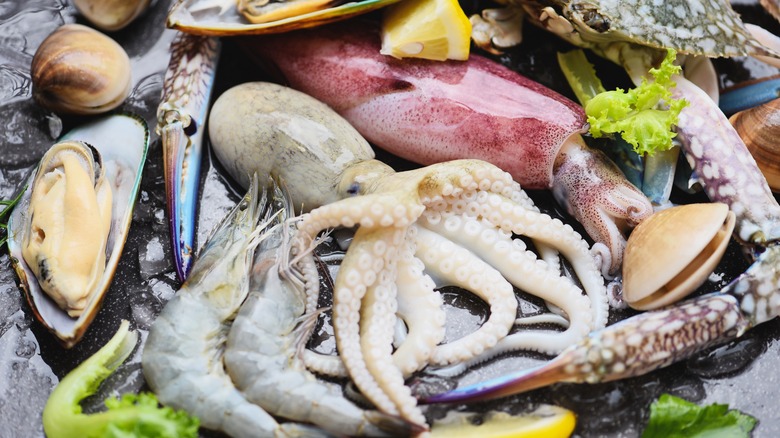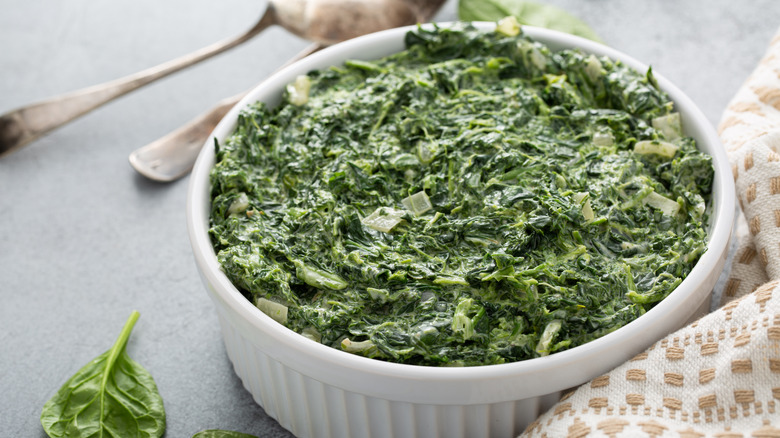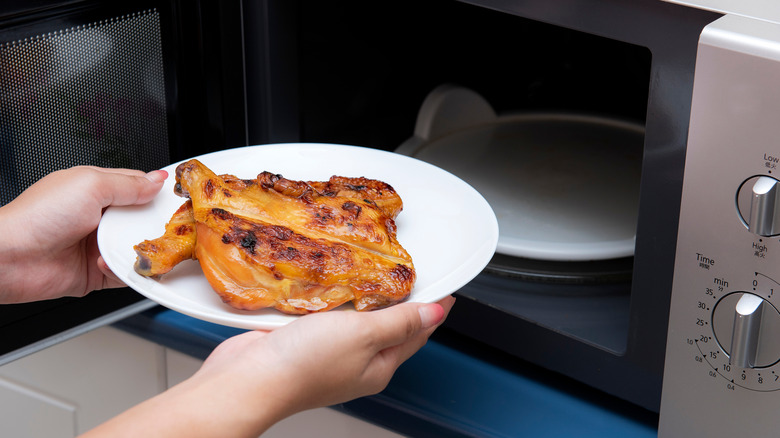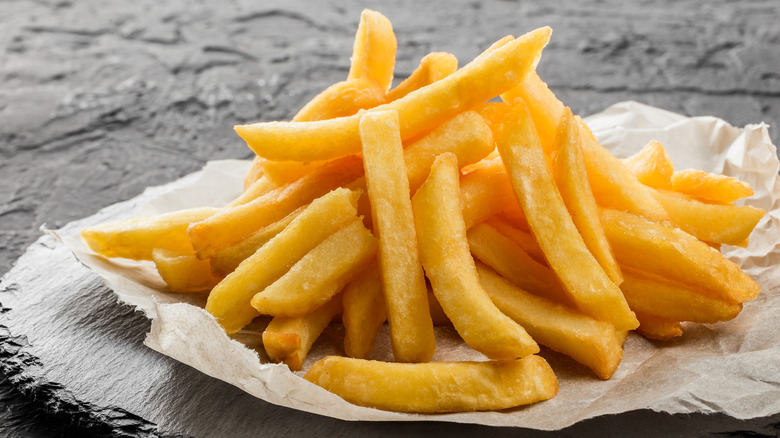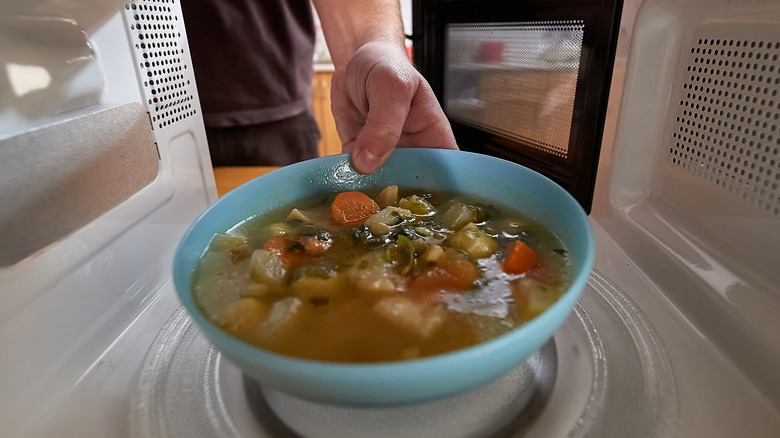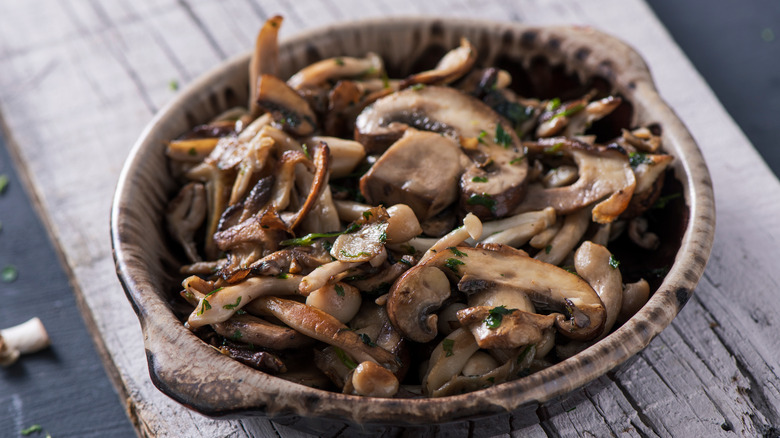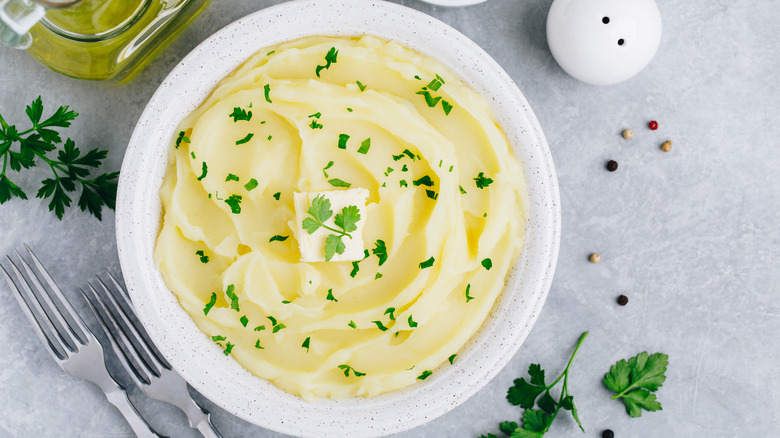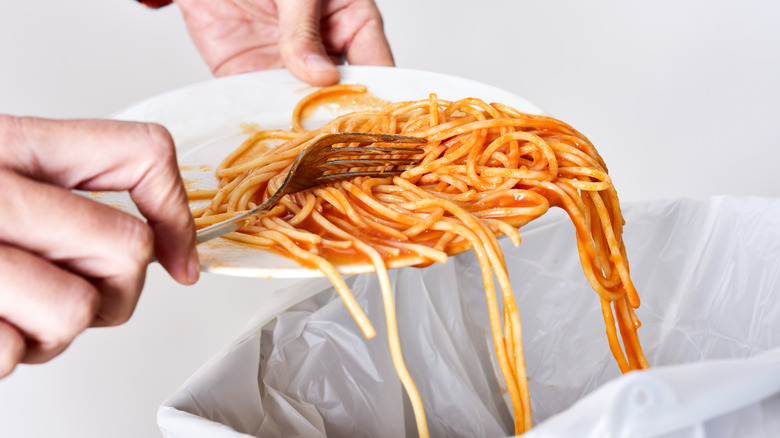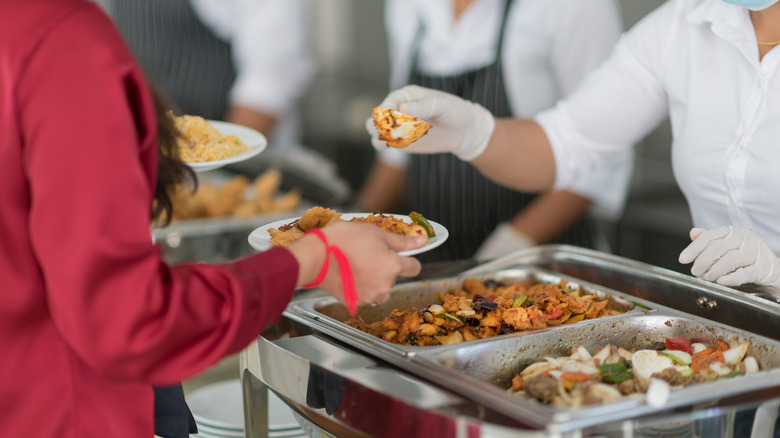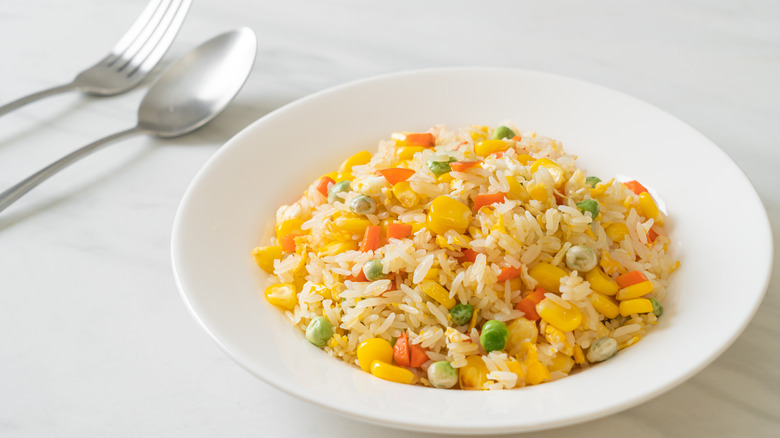The Most Dangerous Leftovers You Might Have In Your Fridge
After enjoying a fantastic meal, many of us begin dreaming about eating leftovers. Sometimes, the leftovers are tastier than the initial meal (via Food Network). Unfortunately, though, not all leftovers are created equal. While some leftover food tastes spectacular the second time around, other times, it can end up making you sick.
Food poisoning isn't as rare as you may think. It's estimated that 48 million or about one in six Americans get food poisoning every year (via Centers for Disease Control and Prevention). Many of these cases can be attributed to leftovers that weren't stored properly. While obvious signs, like the appearance of mold on food and putrid odors, can indicate leftovers that have gone bad, these dangers aren't always visible.
It's very important to learn which kinds of foods are the most dangerous when eaten as leftovers. This way, the next time you go to your fridge to grab a second round of your favorite foods, you'll be fully aware of the risks you might be taking.
Pizza
One of the yummiest leftovers of all has to be pizza: Cold pizza is so delicious that around 53% of Americans prefer leftover pizza to hot pizza that's fresh out of the oven (via Delish). In fact, studies have shown that pizza is a staple food for many Americans, particularly college students (via The Daily Texan). However, leftover pizza can be quite dangerous if you don't take precautions.
First of all, to prevent foodborne illness, you shouldn't let pizza sit out on the counter for longer than two hours (via Los Angeles Times). Instead, put the remaining slices in the refrigerator in an airtight box or in a sealed plastic bag as soon as possible (via Eat This, Not That). Secondly, pizza tends to be safe for consumption for a few days after refrigeration. Even if you're a cold pizza fanatic, you should think twice before you gobble up a few slices of that pizza you ordered from your favorite pizza chain a week ago.
Seafood
Eating leftover seafood is a questionable decision for several different reasons and can be quite risky (via The Healthy). Reheating foods like fish can lead to a strong smell and affect the texture of the fish. Even the most succulent of fish filets can turn into a rubbery, nearly inedible mess after being reheated. According to the U.S. Department of Agriculture, cooked seafood can be safely stored in the refrigerator for three to four days.
If cooked seafood is stored longer than four days, the possibility of bacterial growth makes it dangerous to eat, so your best bet is to throw it out. Uncooked seafood should be consumed within a few days (via The Daily Mail). Raw shrimp, raw scallops, fresh mussels, and shucked oysters, in particular, can only last for one or two days in your fridge. Additionally, seafood should not be left at room temperature for more than two hours.
Spinach
According to Popeye (and health experts), spinach is a food with multiple different health benefits (via Medical Health News). Spinach is often classified as a superfood because it contains nutrients that are beneficial to your eyes, bones, hair, skin, and heart. And, while eating spinach every day, won't instantaneously give you gigantic muscles (though Popeye might disagree), it's a highly nutritious dietary choice that will nourish your body.
However, you should be careful about reheating spinach in the microwave (via NDTV Food). Spinach is high in nitrates and can become toxic when reheated. Additionally, heating and then reheating this green leafy vegetable could have the unintended result of oxidizing the iron in spinach, making it dangerous to consume.
Don't hesitate to eat fresh spinach or cooked spinach. You can even guzzle it out of the can like a modern-day Popeye. Whichever way you choose to consume spinach, just make sure that you're taking the necessary precautions!
Chicken
When thawing chicken and handling raw chicken due, precautions must be taken due to the possible presence of salmonella. If you've ever suffered from salmonella infection, you know the symptoms (which include nausea, vomiting, chills, fever, and diarrhea) are terrible and should be avoided by taking all possible measures (via Mayo Clinic). Undercooking chicken can also lead to salmonella infection, so make sure your chicken is well done.
Additionally, improperly reheating chicken can also be dangerous. Cooking does not permanently eliminate bacteria in chicken and it's possible for bacteria like salmonella to regrow even after cooking. According to the World Health Organization, microwaves do not always penetrate food with even levels of heat, which increases the possibility of infection. Reheating chicken in an oven or on a stovetop and making sure that it reaches an internal temperature of 165 degrees Fahrenheit is likely to be one of the safest ways of reheating chicken.
Oily Foods
Oily foods like onion rings and french fries need to be reheated with care as the oil in these foods that can pose a problem (via Insider). If these oils get too hot during the reheating process, they could produce fumes that contain toxins. If you're going to reheat oily foods, the best practice is to put them in the oven at a low temperature to safely heat them up.
That being said, most fried foods, including even the best fast-food fries and the tastiest onion rings, are not worth reheating (via Cooking Light). The texture becomes overly dry, which affects the flavor and causes the fried items to turn into a mushy disaster. Most of the time, you're better off getting a new batch of your favorite fried foods rather than trying to reheat what you find in your fridge.
Previously reheated leftovers
Reheated leftovers are not always safe to consume: It may be dangerous to reheat the same leftovers multiple times, even if you follow all the correct safety protocols when reheating your leftovers the first time (via BBC Good Food). Each time you reheat the same dish of leftovers, the chances of that food giving you food poisoning increase as well. This is why it's best to only reheat the amount of food that you plan to consume.
For instance, if you make a large amount of soup to last you and your family for a few days, it's a good idea to only reheat individual portions instead of reheating the entire pot of soup. While it may take some added effort and organization, it's certainly worth it to avoid getting food poisoning.
Batch cooking is a great way to save both time and money. It entails storing cooked and raw portions of different foods and mixing them together into quick meals when needed. Batch cooking is a great way of consuming convenient and safe meals.
Mushrooms
Mushrooms are an extremely healthy food: They contain selenium, copper, and magnesium. Additionally, they lower your chances of developing many kinds of cancer such as breast cancer and prostate cancer (via WebMD). They also contain the same amount of potassium as a banana and a notable amount of vitamin D.
However, you should reconsider eating leftovers that contain mushrooms. Firstly, the protein in mushrooms can be compromised by the microorganisms present in this food if they are improperly stored (via Insider). Additionally, mushrooms deteriorate quickly since they're a kind of fungi (via Foodal). For this reason, it's essential to ensure that they are cooked and stored properly. Ideally, they should be consumed within a week after refrigeration.
If you really must reheat mushrooms, the European Food Information Council recommends warming them at 158 degrees Fahrenheit (via The Independent). That being said, there's always a legitimate chance that reheated mushrooms will give you a stomachache. When in doubt, toss leftover mushrooms in the trash. It's just not worth the risk.
Potatoes
Potatoes are very popular in the U.S.; they account for 15% of farm sales (via Vox). Many Americans consume potatoes in various forms, from mashed potatoes to scalloped potatoes, to anything in between. Be warned, though: After the meal is done and before the conversations have ended, dishes made from potatoes need an extra amount of care if you're planning to store them and eat them later on.
While it may be tempting to leave potatoes covered in foil on the counter to save them for later, doing this can cause the growth of Clostridium botulinum. This bacteria can cause an illness called botulism which causes weakness and may lead to difficulty breathing (via Food Safety News). Though it may seem counterintuitive, covering the potatoes is what causes the problem as Clostridium botulinum needs a low oxygen environment in order to multiply. The best course of action with potatoes is to store them in the refrigerator sans any foil. The leftover potatoes should be safe to eat for about four days (via Healthline).
Eggs
Ideally, eggs should be eaten fresh after preparation, and that includes dishes that contain eggs such as omelets, casseroles, and quiches. If you do want to store these foods, they should be refrigerated within two hours (via U.S. Food & Drug Administration). Just like with raw chicken and leftover chicken, the primary worry with regard to eggs is salmonella. It is imperative to ensure that cooked and refrigerated eggs are reheated to 165 degrees Fahrenheit before consumption.
If you're transporting egg salad, deviled eggs, or even totally intact hard-boiled eggs, be sure to put them in a cooler because the two-hour rule still applies. If you don't have a cooler and you take something with eggs in it on a picnic, the smartest thing to do is throw away any leftovers once you get back home. The food may still taste and look okay but the risk of salmonella illness is simply too high.
Pasta
If you happily enjoy cold pizza, you may be tempted to try cold pasta leftovers as well, particularly if you enjoy pasta salad. And while it may be tempting to keep leftover pasta on your kitchen counter so that you can eat it for your next meal, it can be dangerous to do so.
Leftover pasta can literally be deadly: According to Health, a 20-year-old man in Belgium died after eating leftover pasta. Closer to home, a college student in the state of Massachusetts contracted food poisoning and went into septic shock after eating a leftover dish of lo mein and chicken.
If you find leftover pasta in your fridge, and you aren't sure about how long it has been in there, your best bet is to put it in the garbage. And, if you're cooking and have made too much pasta, make sure you keep in mind that like many other foods, leftover pasta needs to be put into your fridge within two hours of cooking (via Substitute Cooking).
Buffet Food
Once you begin learning about food safety, you soon realize that there are some serious hygiene concerns surrounding buffets (via Vice). The food sits out for hours at a time; additionally, cross-contamination with other foods and multiple different customers coming into contact with your food is also a concern. Many buffet chains don't allow you to take leftovers home (via Foodly). Buffet restaurants are actually doing you a favor by instituting this rule: It is not a good idea to take home and reheat leftover buffet food, mostly due to possible bacteria growth.
Since it's practically impossible to know how long the buffet food was sitting out at room temperature before it arrived on your plate, you don't know how long you have before the food must be refrigerated. Even if eating the buffet food didn't make you sick while you were at the buffet restaurant, there's a decent chance that the bacteria in the food is already actively multiplying because it has been sitting at room temperature for extended periods of time.
Rice
Rice is a food that's found across countless cuisines (via WorldAtlas). If you regularly consume rice, you have a lot of company around the globe. That being said, leftover rice can be quite dangerous. That's due to the fact that some rice may have Bacillus cereus spores that can survive even after being cooked (via NHS).
If rice is left unrefrigerated at room temperature for too long, this could cause the bacteria to multiply and may lead to food poisoning. For this reason, it's best to only make enough rice for one meal. Luckily, cooking rice is easy and quick.
If you have leftover rice in the fridge, it must be consumed within three days and discarded after four days (via Medical News Today). Check for any oddities regarding flavor, smell, or appearance before consuming. If anything at all is amiss or you have any doubts about whether or not the rice has gone bad, toss it out.
